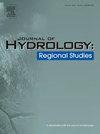Escherichia coli in the Niger River: Links to environmental variables and anthropogenic activities in Niamey city, Niger
IF 4.7
2区 地球科学
Q1 WATER RESOURCES
引用次数: 0
Abstract
Study region
Middle Niger River, upstream to downstream of Niamey city, Sahel, West Africa.
Study focus
Understanding surface water pollution dynamics and identifying its main drivers is particularly important in regions where surface waters are largely used without proper treatment. This study is focused on the Niger River water and assesses E. coli numbers, and physicochemical parameters upstream and downstream of Niamey. Data collected over three years, supplemented by occasional campaigns, aimed to determine the spatial and temporal variability of water quality.
New hydrological insights for the region
SPM and E. coli showed high values during the rainy season, peaking before the Red flood. E. coli increased from the first rainfall events in Niamey with a peak occurring before SPM peak. Distinct sources play an important role on their seasonal dynamics; E. coli mainly originates from urban areas along the Niger River, while SPM comes from right-hand tributaries upstream of Niamey. Downstream of Niamey, E. coli were significantly higher than upstream, highlighting the city's substantial contribution to fecal contamination through wastewater discharges, particularly on the left bank. No significant differences between upstream and downstream were observed in the other physicochemical parameters analyzed. Considering spatial distribution in E. coli sources and environmental parameters such as rainfall and SPM is of major and global importance for understanding and addressing fecal contamination in urban environments.
尼日尔河中的大肠杆菌:与尼日尔尼亚美市环境变量和人为活动的联系
研究区域:尼日尔河中游,西非萨赫勒地区尼亚美市上游至下游。研究重点:在地表水大量使用而未经适当处理的地区,了解地表水污染动态并确定其主要驱动因素尤为重要。本研究的重点是尼日尔河的水,并评估大肠杆菌数量,以及尼亚美上游和下游的理化参数。三年来收集的数据,加上偶尔开展的活动,旨在确定水质的空间和时间变化。该地区新的水文信息显示,spm和大肠杆菌在雨季高值,在红色洪水之前达到峰值。大肠杆菌从尼亚美第一次降雨事件开始增加,峰值出现在SPM高峰之前。不同的来源对它们的季节动态起重要作用;大肠杆菌主要来自尼日尔河沿岸的城市地区,而SPM则来自尼亚美上游的右手支流。尼亚美下游的大肠杆菌含量明显高于上游,这凸显了该市通过废水排放造成的粪便污染,尤其是在左岸。在其他理化参数分析中,上游和下游之间没有显著差异。考虑大肠杆菌来源的空间分布以及降雨和SPM等环境参数对于理解和解决城市环境中的粪便污染具有重要的全球意义。
本文章由计算机程序翻译,如有差异,请以英文原文为准。
求助全文
约1分钟内获得全文
求助全文
来源期刊

Journal of Hydrology-Regional Studies
Earth and Planetary Sciences-Earth and Planetary Sciences (miscellaneous)
CiteScore
6.70
自引率
8.50%
发文量
284
审稿时长
60 days
期刊介绍:
Journal of Hydrology: Regional Studies publishes original research papers enhancing the science of hydrology and aiming at region-specific problems, past and future conditions, analysis, review and solutions. The journal particularly welcomes research papers that deliver new insights into region-specific hydrological processes and responses to changing conditions, as well as contributions that incorporate interdisciplinarity and translational science.
 求助内容:
求助内容: 应助结果提醒方式:
应助结果提醒方式:


